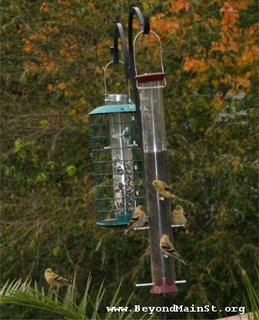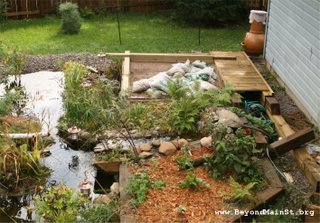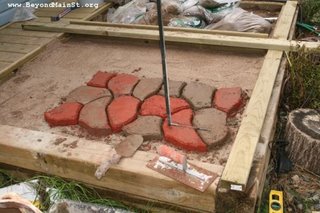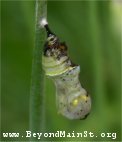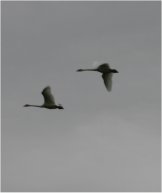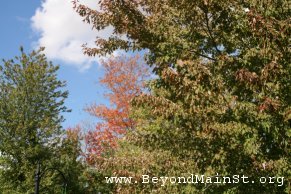 After what felt like a week of rain, clouds, and cold, Apollo's chariot made its appearance bright and early this morning. I couldn't have asked for a nicer day to end the weekend; clear skies, and temperatures hovering in the upper 60's! Took advantage of it to re-screed and lay as many bricks as our stash of concrete would allow.
After what felt like a week of rain, clouds, and cold, Apollo's chariot made its appearance bright and early this morning. I couldn't have asked for a nicer day to end the weekend; clear skies, and temperatures hovering in the upper 60's! Took advantage of it to re-screed and lay as many bricks as our stash of concrete would allow.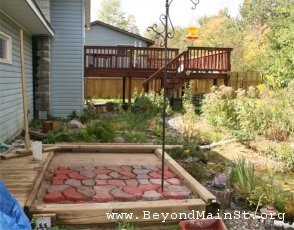 I think I'm finally hitting my patio-laying stride, which is rather sad as I only have about 3 feet to go. Instead of just randomly placing the blocks I've worked them into what I think of as a 'Lake Superior' pattern, with brown as the lake and streams and red as the mainland and islands.
I think I'm finally hitting my patio-laying stride, which is rather sad as I only have about 3 feet to go. Instead of just randomly placing the blocks I've worked them into what I think of as a 'Lake Superior' pattern, with brown as the lake and streams and red as the mainland and islands.Found each form takes about 1 1/4 60 lb. bags of concrete, and about 1 can of color. Since I'm doing approximately half red and half brown, that means mixing the cement, color, and water in separate tubs, then transporting them from the tubs to the work site in small containers. Care has to be taken to pour the cement carefully (the colors look shoddy when mixed), and to make a red run and a brown run when leveling and smoothing the concrete, being careful to wash the trowel between each run.
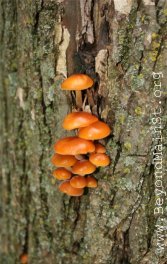 The color washes pretty well out of decking, aluminum siding, and dried blocks, but not so much when it comes to clothing. This means that in addition to the cement ($2.35 a bag X 14), sand ($58 so far, though it turns out I bought more than I needed), the form/mold ($12) and the cement color mix ($4.50 X 6), I need to replace a pair of loafers ($20), pants ($25), a shirt ($20), and socks (depends on how you divide them I guess; $1?) which means this project is going to cost me a grand total of approx $208 by the time I'm done. That's not counting the time I've put into this project. I have no idea what to pay myself for manual labor.
The color washes pretty well out of decking, aluminum siding, and dried blocks, but not so much when it comes to clothing. This means that in addition to the cement ($2.35 a bag X 14), sand ($58 so far, though it turns out I bought more than I needed), the form/mold ($12) and the cement color mix ($4.50 X 6), I need to replace a pair of loafers ($20), pants ($25), a shirt ($20), and socks (depends on how you divide them I guess; $1?) which means this project is going to cost me a grand total of approx $208 by the time I'm done. That's not counting the time I've put into this project. I have no idea what to pay myself for manual labor.Not bad when you compare it to paying professionals, or even the kid next door to have it done, but how's it compare to buying the patio blocks pre-made? The patio blocks I saw ranged from around $2 each to around $4, so let's average and say $3. At 7 blocks to a set that would make $21 a set. That would have made around $252 for the blocks, plus $58 (when you factor in that I'd still need to screed a 1" layer of sand, and, being a patio rookie, I'd still screw up and buy too much) which puts us at around $310. Looks like even with the red-splotched shoes and Dockers I saved. Just not by much.
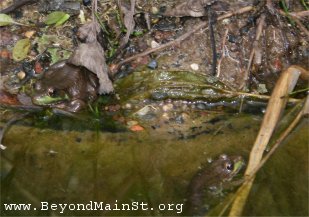 In other news, yes Virginia there are still frogs in my pond. You'd think that with the average temp dropping below 50 some days (and below 40 some nights,) they'd start burrowing in the mud around the banks, but I counted at least six Green Frogs sunning themselves in the shallows this morning. Hope they're not getting two comfy, as the project I have to take on next weekend is going to involve draining the plastic pond and smashing it into small enough pieces to cram into the trash bin.
In other news, yes Virginia there are still frogs in my pond. You'd think that with the average temp dropping below 50 some days (and below 40 some nights,) they'd start burrowing in the mud around the banks, but I counted at least six Green Frogs sunning themselves in the shallows this morning. Hope they're not getting two comfy, as the project I have to take on next weekend is going to involve draining the plastic pond and smashing it into small enough pieces to cram into the trash bin.Seems that when I added on the second pond basin and the stream to connect the two basins with rubber liner I forgot to take into account the fact that the sun heats the plastic basin to the point where it expands and contracts on a daily basis. Alone, and in a bed of sand, you'd never notice this, but try to couple it with a non-conductive rubber liner and no among of sealant, self-expanding foam, or bolts will keep a watertight seal.
Which means you're going to have leaks.
Which means adding more water via a hose on a timer on a daily basis. Which not only flies in the face of water conservation, but costs money, and forces the filters and the fish to cope with a daily influx of the brown rust crap from our water table. While I'm not exactly giddy about the prospect of rebuilding the first basin, it will give me an opportunity to excavate a deeper stream for my goldfish. If they continue growing at this rate, they'll certainly need it.
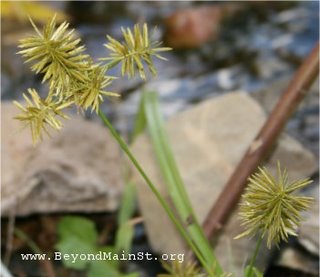 Seems to have been a good year for native gardening; the Harebell's still blooming, the Pasqueflower is thick, and the stand of Swamp Milkweed flourishing by the driveway is almost as tall as I am. We've also got a transplant from Long Lake in Stillwater (I've included it to the left), some sort of rush-type plant with grass-like leaves and five balls of green spikes on each stalk.
Seems to have been a good year for native gardening; the Harebell's still blooming, the Pasqueflower is thick, and the stand of Swamp Milkweed flourishing by the driveway is almost as tall as I am. We've also got a transplant from Long Lake in Stillwater (I've included it to the left), some sort of rush-type plant with grass-like leaves and five balls of green spikes on each stalk.Anyways, we're planning on a quiet evening and maybe a little archery practice here.
